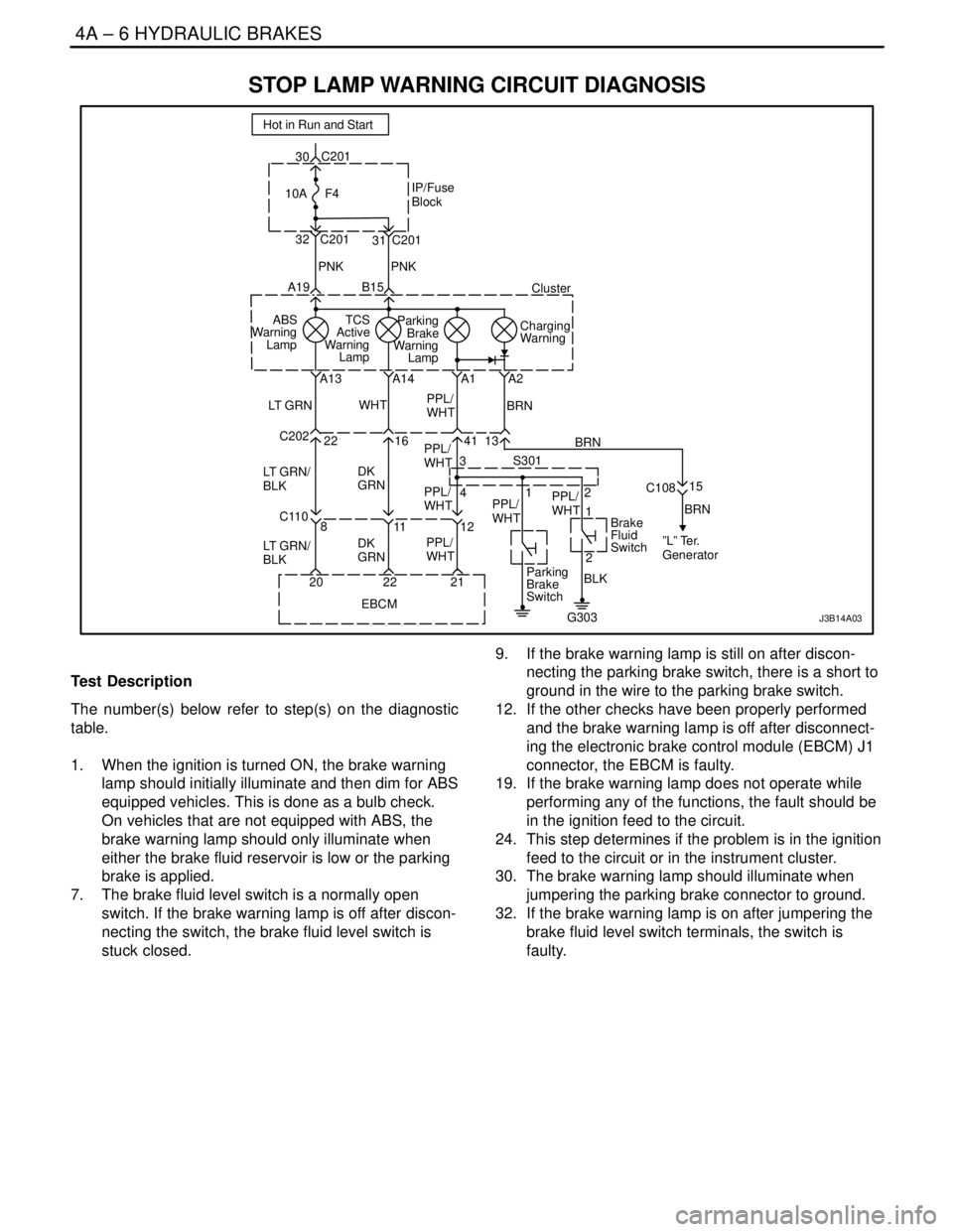instrument cluster DAEWOO NUBIRA 2004 Service Repair Manual
[x] Cancel search | Manufacturer: DAEWOO, Model Year: 2004, Model line: NUBIRA, Model: DAEWOO NUBIRA 2004Pages: 2643, PDF Size: 80.54 MB
Page 253 of 2643

ENGINE CONTROLS 1F – 7
DAEWOO V–121 BL4
Parameter ValueScaling
A/C RequestYes/NoNo
A/C ClutchOn/OffOff
Fuel Pump CommandOn/OffOn
Closed LoopYes/NoYe s
Throttle At IdleYes/NoNo
O2 Ready (B1–S1)Yes/NoYe s
Knock PresentYes/NoNo
Fan LowOn/OffOn/Off
Fan HighOn/OffOn/Off
TCC Engaged (Only AT)Yes/NoYe s
Park/Neutral (Only AT)P/N and R/N/DP/N
Fuel Level InputVvaries
Fuel Level Output%varies
Fuel Trim Cell–18
G–SensorV1.1 – 3.7 V (Non–ABS Only)
Engine RuntimeHH:MM:SSHours:Minutes:Seconds
* Condition: Warmed up, idle, park or neutral, A/C off
ENGINE DATA DISPLAY TABLE
DEFINITIONS
ECM Data Description
The following information will assist in diagnosing emis-
sion or driveability problems. A first technician can view
the displays while the vehicle is being driven by second
technician. Refer to Powertrain On–Board Diagnostic
(EOBD) System Check for addition information.
A/C Clutch
The A/C Relay represents the commanded state of the
A/C clutch control relay. The A/C clutch should be en-
gaged when the scan tool displays ON.
A/C Pressure
The A/C High Side displays the pressure value of the A/C
refrigerant pressure sensor. The A/C High Side helps to
diagnose the diagnostic trouble code (DTC) P0533.
A/C Request
The A/C Request represents whether the air conditioning
is being requested from the HVAC selector. The input is re-
ceived by the instrument panel cluster and then sent serial
data to the ECM and finally to the scan tool over KWP 2000
serial data.
Air Fuel Ratio
The Air Fuel Ration indicates the air to fuel ratio based on
the Front Heated Oxygen Sensor (HO2S1) inputs. The
ECM uses the fuel trims to adjust fueling in order to at-
tempt to maintain an air fuel ratio of 14.7:1.BARO
The Barometric Pressure (BARO) sensor measures the
change in the intake manifold pressure which results from
altitude changes. This value is updated at ignition ON and
also at Wide Open Throttle (WOT).
Base Injection PWM
Indicates the base Pulse Width Modulation (PWM) or ON
time of the indicated cylinder injector in milliseconds.
When the engine load is increased, the injector pulse width
will increase.
Calculated Air Flow
The calculated air flow is a calculation based on manifold
absolute pressure. The calculation is used in several diag-
nostics to determine when to run the diagnostics.
Desired Idle Speed
The ECM commands the idle speed. The ECM compen-
sates for various engine loads in order to maintain the de-
sired idle speed. The actual engine speed should remain
close to the desired idle under the various engine loads
with the engine idling.
Engine Coolant Temperature
The Engine Coolant Temperature (ECT) sensor sends en-
gine temperature information to the ECM. The ECM sup-
plies 5 volts to the engine coolant temperature sensor cir-
cuit. The sensor is a thermistor which changes internal
resistance as temperature changes. When the sensor is
cold (internal resistance high), the ECM monitors a high
voltage which it interprets as a cold engine. As the sensor
warms (internal resistance decreases), the voltage signal
will decrease and the ECM will interpret the lower voltage
as a warm engine.
Page 255 of 2643

ENGINE CONTROLS 1F – 9
DAEWOO V–121 BL4
Spark Advance
This is a display of the spark advance Ignition Coil (IC) cal-
culation which the ECM is programming in the ignition sys-
tem. It computes the desired spark advance using data
such as engine temperature, rpm, engine load, vehicle
speed and operating mode.
TCC Engaged
When the brake pedal is applied, the Torque Converter
Clutch (TCC) brake switch sends a signal to the ECM to
disengage the TCC and disable the cruise control.
Total Misfire Current Counter
Indicates the total number of misfires that have been de-tected in all the cylinders after 100 engine cycles. One
cycle equals one complete 4 stroke cycle. The total misfire
only increments during the steady state cruise conditions.
TP Sensor
The ECM uses the TP Sensor in order to determine the
amount of the throttle demanded by the vehicle’s operator.
The TP Sensor reads between 0.36–0.96 volts at idle to
above 4 volts at WOT.
Vehicle Speed
The vehicle speed sensor signal is converted into mph or
km/h for display. The vehicle speed output from the ECM
is 4000 pulses per mile. The scan tool uses the KWP 2000
serial data from the ECM to obtain vehicle speed, while the
Instrument Panel Cluster (IPC), cruise control module and
the chime alarm module use the 4000 ppm output.
Page 305 of 2643

ENGINE CONTROLS 1F – 59
DAEWOO V–121 BL4
Malfunction Indicator Lamp On Steady (1.4L/1.6L DOHC)
StepActionValue(s)YesNo
1Perform an On–Board Diagnostic (EOBD) system
check.
Is the check complete.–Go to Step 2Go to
”On–Board
Diagnostic Sys-
tem Check”
21. Turn the ignition switch to LOCK.
2. Install the scan tool to the Data Link Connector
(DLC).
3. Command the Malfunction Indicator Lamp
(MIL) ON and OFF.
Does the MIL turn ON and OFF when commanded?–Go to Step 7Go to Step 3
31. Turn the ignition switch to LOCK.
2. Disconnect the Engine Control Module (ECM)
connector.
3. Turn the ignition switch to ON.
Is the MIL off?–Go to Step 6Go to Step 4
4Check the MIL control circuit for a short to ground
and repair as needed.
Is the repair complete?–Go to Step 7Go to Step 5
5Replace the instrument panel cluster. Refer to Sec-
tion 9E, Instrumentation/Driver Information.
Is the repair complete?–Go to Step 7–
6Replace the ECM.
Is the repair complete?–Go to Step 7–
71. Using the scan tool, clear the Diagnostic
Trouble Codes(DTCs).
2. Attempt to start the engine.
Does the engine start and continue to run?–Go to Step 8Go to Step 1
81. Allow the engine to idle until normal operating
temperature is reached.
2. Check if any DTCs are set.
Are any DTCs displayed that have not been diag-
nosed?–Go to
Applicable DTC
tableSystem OK
Page 307 of 2643

ENGINE CONTROLS 1F – 61
DAEWOO V–121 BL4
Malfunction Indicator Lamp On Steady (1.8L DOHC)
StepActionValue(s)YesNo
1Perform an On–Board Diagnostic (EOBD) system
check.
Is the check complete.–Go to Step 2Go to
”On–Board
Diagnostic Sys-
tem Check”
21. Turn the ignition switch to LOCK.
2. Install the scan tool to the Data Link Connector
(DLC).
3. Command the Malfunction Indicator Lamp
(MIL) ON and OFF.
Does the MIL turn ON and OFF when commanded?–Go to Step 7Go to Step 3
31. Turn the ignition switch to LOCK.
2. Disconnect the Engine Control Module (ECM)
connector.
3. Turn the ignition switch to ON.
Is the MIL off?–Go to Step 6Go to Step 4
4Check the MIL control circuit for a short to ground
and repair as needed.
Is the repair complete?–Go to Step 7Go to Step 5
5Replace the instrument panel cluster. Refer to
Section 9E, Instrumentation/Driver Information.
Is the repair complete?–Go to Step 7–
6Replace the ECM.
Is the repair complete?–Go to Step 7–
71. Using the scan tool, clear the Diagnostic
Trouble Codes(DTCs).
2. Attempt to start the engine.
Does the engine start and continue to run?–Go to Step 8Go to Step 1
81. Allow the engine to idle until normal operating
temperature is reached.
2. Check if any DTCs are set.
Are any DTCs displayed that have not been diag-
nosed?–Go to
” Applicable
DTC table”System OK
Page 352 of 2643

1F – 106IENGINE CONTROLS
DAEWOO V–121 BL4
DATA LINK CONNECTOR DIAGNOSIS (1.4L/1.6L DOHC)
Circuit Description
The provision for communicating with the Engine Control
Module (ECM) is the Data Link Connector (DLC). It is lo-
cated under the instrument panel. The DLC is used to con-
nect the scan tool. Battery power and ground is supplied
for the scan tool through the DLC. The Keyword 2000 seri-
al data circuit to the DLC allows the ECM to communicate
with the scan tool. A Universal Asynchronous Receiver
Transmitter (UART) serial data line is used to communi-
cate with the other modules such as the Electronic Brake
Control Module (EBCM), the Supplemental Inflatable Re-
straint (SIR) system. and the Instrument Panel Cluster.
Diagnostic Aids
Ensure that the correct application (model line, car year,
etc.) has been selected on the scan tool. If communication
still cannot be established, try the scan tool on another ve-
hicle to ensure that the scan tool or cables are not the
cause of the condition.
An intermittent may be caused by a poor connection,
rubbed through wire insulation, or a broken wire inside the
insulation.
Any circuitry that is suspected of causing an intermittent
complaint should be thoroughly checked for the following
conditions:
S Backed–out terminals.S Improper mating of terminals.
S Broken locks.
S Improperly formed or damaged terminals.
S Poor terminal–to–wiring connection.
S Physical damage to the wiring harness.
S Corrosion.
Test Description
Number(s) below refer to the step number(s) on the Diag-
nostic Table.
1. The On–Board Diagnostic (EOBD) System Check
prompts the technician to complete some basic
checks and store the freeze frame and failure re-
cords data on the scan tool if applicable. This
creates an electronic copy of the data taken when
the malfunction occurred. The information is then
stored on the scan tool for later reference.
2. Unlike the UART serial data circuit, the only time a
Class II serial data circuit has any voltage on it is
when a scan tool asks the ECM for information and
sends the information out.
5. Locate and repair any shorts that may have caused
the fuse to open before replacement, if the no volt-
age condition was due to an open fuse.
10. The scan tool or associated cables could be mal-
functioning. Refer to the scan tool’s manual for re-
pair information.
Page 354 of 2643

1F – 108IENGINE CONTROLS
DAEWOO V–121 BL4
DATA LINK CONNECTOR DIAGNOSIS (1.8L DOHC)
Circuit Description
The provision for communicating with the Engine Control
Module (ECM) is the Data Link Connector (DLC). It is lo-
cated under the instrument panel. The DLC is used to con-
nect the scan tool. Battery power and ground is supplied
for the scan tool through the DLC. The Keyword 2000 seri-
al data circuit to the DLC allows the ECM to communicate
with the scan tool. A Universal Asynchronous Receiver
Transmitter (UART) serial data line is used to communi-
cate with the other modules such as the Electronic Brake
Control Module (EBCM), the Supplemental Inflatable Re-
straint (SIR) system. and the Instrument Panel Cluster.
Diagnostic Aids
Ensure that the correct application (model line, car year,
etc.) has been selected on the scan tool. If communication
still cannot be established, try the scan tool on another ve-
hicle to ensure that the scan tool or cables are not the
cause of the condition.
An intermittent may be caused by a poor connection,
rubbed through wire insulation, or a broken wire inside the
insulation.
Any circuitry that is suspected of causing an intermittent
complaint should be thoroughly checked for the following
conditions:
S Backed–out terminals.S Improper mating of terminals.
S Broken locks.
S Improperly formed or damaged terminals.
S Poor terminal–to–wiring connection.
S Physical damage to the wiring harness.
S Corrosion.
Test Description
Number(s) below refer to the step number(s) on the Diag-
nostic Table.
1. The On–Board Diagnostic (EOBD) System Check
prompts the technician to complete some basic
checks and store the freeze frame and failure re-
cords data on the scan tool if applicable. This
creates an electronic copy of the data taken when
the malfunction occurred. The information is then
stored on the scan tool for later reference.
2. Unlike the UART serial data circuit, the only time a
Class II serial data circuit has any voltage on it is
when a scan tool asks the ECM for information and
sends the information out.
5. Locate and repair any shorts that may have caused
the fuse to open before replacement, if the no volt-
age condition was due to an open fuse.
10. The scan tool or associated cables could be mal-
functioning. Refer to the scan tool’s manual for re-
pair information.
Page 1021 of 2643

HYDRAULIC BRAKES 4A – 5
DAEWOO V–121 BL4
DIAGNOSIS
BRAKE SYSTEM TESTING
Brakes should be tested on a dry, clean, reasonably
smooth and level roadway. A true test of brake perfor-
mance cannot be made if the roadway is wet, greasy, or
covered with loose dirt whereby all tires do not grip the
road equally. Testing will also be adversely affected if the
roadway is crowned so as to throw the weight so roughly
that the wheels tend to bounce.
Test the brakes at different vehicle speeds with both light
and heavy pedal pressure; however, avoid locking the
brakes and sliding the tires. Locked brakes and sliding
tires do not indicate brake efficiency since heavily braked,
but turning, wheels will stop the vehicle in less distance
than locked brakes. More tire–to–road friction is present
with a heavily–braked, turning tire than with a sliding tire.
Because of the high deceleration capability, a firmer pedal
may be felt at higher deceleration levels.
There are three major external conditions that affect brake
performance:
S Tires having unequal contact and grip of the road
will cause unequal braking. Tires must be equally
inflated, and the tread pattern of the right and the
left tires must be approximately equal.
S Unequal loading of the vehicle can affect the brake
performance since the most heavily loaded wheels
require more braking power, and thus more braking
effort, than the others.
S Misalignment of the wheels, particularly conditions
of excessive camber and caster, will cause the
brakes to pull to one side.
To check for brake fluid leaks, hold constant foot pressure
on the pedal with the engine running at idle and the shift
lever in NEUTRAL. If the pedal gradually falls away with
the constant pressure, the hydraulic system may be leak-
ing. Perform a visual check to confirm any suspected
leaks.
Check the master cylinder fluid level. While a slight drop
in the reservoir level results from normal lining wear, an ab-
normally low level indicates a leak in the system. The hy-
draulic system may be leaking either internally or external-
ly. Refer to the procedure below to check the master
cylinder. Also, the system may appear to pass this test
while still having a slight leak. If the fluid level is normal,
check the vacuum booster pushrod length. If an incorrect
pushrod length is found, adjust or replace the rod.
Check the master cylinder using the following procedure:
S Check for a cracked master cylinder casting or
brake fluid leaking around the master cylinder.
Leaks are indicated only if there is at least one drop
of fluid. A damp condition is not abnormal.S Check for a binding pedal linkage and for an incor-
rect pushrod length. If both of these parts are in
satisfactory condition, disassemble the master cyl-
inder and check for an elongated or swollen primary
cylinder or piston seals. If swollen seals are found,
substandard or contaminated brake fluid should be
suspected. If contaminated brake fluid is found, all
the components should be disassembled and
cleaned, and all the rubber components should be
replaced. All of the pipes must also be flushed.
Improper brake fluid, or mineral oil or water in the fluid,
may cause the brake fluid to boil or cause deterioration of
the rubber components. If the primary piston cups in the
master cylinder are swollen, then the rubber parts have
deteriorated. This deterioration may also be evidenced by
swollen wheel cylinder piston seals on the drum brake
wheels.
If deterioration of rubber is evident, disassemble all the hy-
draulic parts and wash the parts with alcohol. Dry these
parts with compressed air before reassembly to keep alco-
hol out of the system. Replace all the rubber parts in the
system, including the hoses. Also, when working on the
brake mechanisms, check for fluid on the linings. If exces-
sive fluid is found, replace the linings.
If the master cylinder piston seals are in satisfactory condi-
tion, check for leaks or excessive heat conditions. If these
conditions are not found, drain the fluid, flush the master
cylinder with brake fluid, refill the master cylinder, and
bleed the system. Refer to ”Manual Bleeding the Brakes”
or”Pressure Bleeding the Brakes” in this section.
BRAKE HOSE INSPECTION
The hydraulic brake hoses should be inspected at least
twice a year. The brake hose assembly should be checked
for road hazard damage, cracks, chafing of the outer cov-
er, and for leaks or blisters. Inspect the hoses for proper
routing and mounting. A brake hose that rubs on a suspen-
sion component will wear and eventually fail. A light and
a mirror may be needed for an adequate inspection. If any
of the above conditions are observed on the brake hose,
adjust or replace the hose as necessary.
WARNING LAMP OPERATION
This brake system uses a BRAKE warning lamp located
in the instrument panel cluster. When the ignition switch
is in the START position, the BRAKE warning lamp should
glow and go OFF when the ignition switch returns to the
RUN position.
The following conditions will activate the BRAKE lamp:
S Parking brake applied. The light should be ON
whenever the parking brake is applied and the igni-
tion switch is ON.
S Low fluid level. A low fluid level in the master cylin-
der will turn the BRAKE lamp ON.
S EBD system is disabled. The light should be ON
when the EBD system is malfunctioning.
Page 1022 of 2643

4A – 6IHYDRAULIC BRAKES
DAEWOO V–121 BL4
STOP LAMP WARNING CIRCUIT DIAGNOSIS
J3B14A03
10A30
F4
32
A19
A13 A14 A1 A2B15 C201
31C201IP/Fuse
Block C201
C202
C110C108 S301 WHT
BRN
BRN
Parking
Brake
SwitchBrake
Fluid
Switch
BLKBRN LT GRN
DK
GRN
DK
GRN LT GRN/
BLK
LT GRN/
BLKPPL/
WHT
PPL/
WHT
PPL/
WHTPPL/
WHT PPL/
WHT
PPL/
WHT ABS
Warning
Lamp TCS
Active
Warning
Lamp Parking
Brake
Warning
Lamp Charging
Warning
Hot in Run and Start
PNK
Cluster PNK
EBCM”L” Ter.
Generator 1 12
2
20 2222 16 41 13
3
4
11 1 215
8
21
G303
Test Description
The number(s) below refer to step(s) on the diagnostic
table.
1. When the ignition is turned ON, the brake warning
lamp should initially illuminate and then dim for ABS
equipped vehicles. This is done as a bulb check.
On vehicles that are not equipped with ABS, the
brake warning lamp should only illuminate when
either the brake fluid reservoir is low or the parking
brake is applied.
7. The brake fluid level switch is a normally open
switch. If the brake warning lamp is off after discon-
necting the switch, the brake fluid level switch is
stuck closed.9. If the brake warning lamp is still on after discon-
necting the parking brake switch, there is a short to
ground in the wire to the parking brake switch.
12. If the other checks have been properly performed
and the brake warning lamp is off after disconnect-
ing the electronic brake control module (EBCM) J1
connector, the EBCM is faulty.
19. If the brake warning lamp does not operate while
performing any of the functions, the fault should be
in the ignition feed to the circuit.
24. This step determines if the problem is in the ignition
feed to the circuit or in the instrument cluster.
30. The brake warning lamp should illuminate when
jumpering the parking brake connector to ground.
32. If the brake warning lamp is on after jumpering the
brake fluid level switch terminals, the switch is
faulty.
Page 1023 of 2643

HYDRAULIC BRAKES 4A – 7
DAEWOO V–121 BL4
Stop Lamp Warning Circuit Diagnosis
StepActionValue(s)YesNo
1Turn the ignition ON.
Is the brake warning lamp always on?–Go to Step 2Go to Step 18
2Check the ABS warning lamp.
Is the ABS warning lamp also on?–Go to Step 3Go to Step 4
3Use a scan tool to check for diagnostic trouble codes
(DTCs) and follow the procedures for any DTCs
found.
Is the lamp still on?–Go to Step 4System OK
4Release the parking brake fully.
Is the lamp off?–System OKGo to Step 5
5Check the brake fluid level.
Is the fluid level OK?–Go to Step 7Go to Step 6
61. Fill the brake fluid reservoir with clean DOT 3
equivalent hydraulic fluid.
2. Replace the cap on the fluid reservoir.
Is the lamp on?– Go to Step 7System OK
7Disconnect the harness connector from the brake
fluid level switch.
Is the lamp on?–Go to Step 9Go to Step 8
8Replace the brake fluid level switch.
Is the repair complete?–System OK–
91. Connect the brake fluid level switch.
2. Disconnect the parking brake switch.
Is the lamp on?–Go to Step 11Go to Step 10
10Replace the parking brake switch.
Is the repair complete?–System OK–
11Connect the parking brake switch.
Is the vehicle equipped with ABS?–Go to Step 12Go to Step 14
121. Turn the ignition OFF.
2. Disconnect the electronic brake control module
(EBCM) connector.
3. Turn the ignition ON.
Is the lamp on?–Go to Step 14Go to Step 13
13Replace the electronic brake control module
(EBCM).
Is the repair complete?–System OK–
141. Turn the ignition OFF.
2. Connect the EBCM connector.
3. Check for a short to ground in the wiring be-
tween the instrument cluster terminal A19(B15)
and the brake fluid level switch.
Is the problem found?–Go to Step 17Go to Step 15
15Check for a short to ground in the wiring between the
instrument cluster terminal A19(B15) and the park-
ing brake switch.
Is the problem found?–Go to Step 17Go to Step 16
Page 1024 of 2643

4A – 8IHYDRAULIC BRAKES
DAEWOO V–121 BL4
StepNo Yes Value(s) Action
16Check for a short to ground in the wiring between the
instrument cluster terminal A19(B15) and the EBCM
connector terminal 21.
Is the problem found?–Go to Step 17Go to Step 18
17Repair the wiring as needed.
Is the repair complete?–System OK–
18Check the brake lamp after doing each of the follow-
ing functions:
S Apply the parking brake.
S Remove the cap from the brake fluid reservoir.
S On vehicles equipped with ABS, command the
lamp on using a scan tool.
Does the brake warning lamp operate for all of these
conditions?–System OKGo to Step 19
19When the operations listed in step 18 were per-
formed, the brake warning lamp did not function.
Did the brake warning lamp fail to light for all of the
operations listed in step 18?–Go to Step 20Go to Step 27
201. Turn the ignition OFF.
2. Inspect the kick panel fuse F4.
Is the fuse OK?–Go to Step 22Go to Step 21
21Replace the fuse.
Is the repair complete?–System OK–
22Inspect the brake warning lamp bulb.
Is the bulb OK?–Go to Step 24Go to Step 23
23Replace the bulb.
Is the repair complete?–System OK–
241. Disconnect the instrument cluster connector.
2. Turn the ignition ON.
3. Measure the voltage at the instrument cluster
connector terminal A19(B15).
Does the voltage measure within the value speci-
fied?11–14 vGo to Step 25Go to Step 26
251. Turn the ignition OFF.
2. Repair the open in the instrument cluster.
Is the repair complete?–System OK–
261. Turn the ignition OFF.
2. Repair the open in the wiring between the in-
strument cluster connector terminal A19(B15)
and the ignition switch.
Is the repair complete?–System OK–
27Apply the parking brake again.
Does the parking brake warning lamp operate with
the parking brake applied?–Go to Step 28Go to Step 30
28Remove the brake fluid reservoir cap.
Does the parking brake warning lamp operate with
the cap from the brake fluid reservoir removed?–Go to Step 29Go to Step 32
29Check for an open between the instrument cluster
connector terminal A1 and the EBCM connector ter-
minal 21.
Is the problem found?–Go to Step 17Go to Step 13